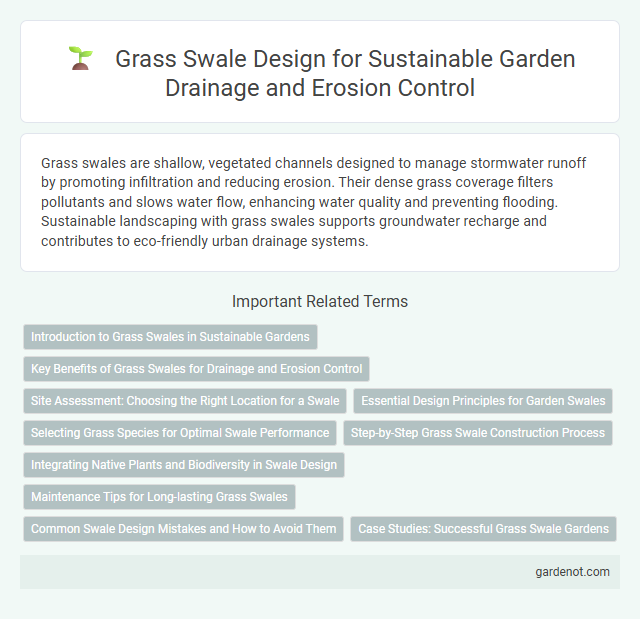Grass swales are shallow, vegetated channels designed to manage stormwater runoff by promoting infiltration and reducing erosion. Their dense grass coverage filters pollutants and slows water flow, enhancing water quality and preventing flooding. Sustainable landscaping with grass swales supports groundwater recharge and contributes to eco-friendly urban drainage systems.
Introduction to Grass Swales in Sustainable Gardens
Grass swales enhance sustainable gardens by managing stormwater runoff naturally while promoting groundwater recharge. These shallow, vegetated channels use native grasses to filter pollutants, reduce soil erosion, and improve water quality. Integrating grass swales supports eco-friendly landscaping by conserving water and fostering biodiversity.
Key Benefits of Grass Swales for Drainage and Erosion Control
Grass swales effectively manage stormwater by slowing runoff and promoting infiltration, significantly reducing surface erosion. They filter pollutants and sediments, enhancing water quality before it reaches natural waterways. These vegetated channels provide sustainable drainage solutions that integrate seamlessly into landscapes, minimizing the need for costly infrastructure.
Site Assessment: Choosing the Right Location for a Swale
Site assessment for a grass swale involves evaluating soil permeability, slope gradient, and existing drainage patterns to ensure optimal water infiltration and flow control. Selecting a location with sufficient sunlight and appropriate topography enhances grass establishment and long-term performance. Proper site selection minimizes erosion risk and maximizes groundwater recharge efficiency in stormwater management systems.
Essential Design Principles for Garden Swales
Grass swales are engineered to manage stormwater by promoting infiltration and slowing runoff, utilizing dense, deep-rooted grasses that stabilize soil and enhance water absorption. Proper grading with a gentle slope between 1% and 5% ensures efficient water conveyance while preventing erosion in garden swales. Integrating native grass species optimized for local climate improves swale performance by increasing filtration capacity and supporting biodiversity.
Selecting Grass Species for Optimal Swale Performance
Selecting grass species for optimal swale performance involves prioritizing varieties with deep root systems and high tolerance to periodic flooding, such as tall fescue and buffalo grass. These grasses enhance water infiltration, reduce soil erosion, and improve pollutant filtration within the swale. Drought-resistant and low-maintenance species contribute to long-term resilience and sustainability of the swale system.
Step-by-Step Grass Swale Construction Process
Grass swale construction begins with site assessment and design, ensuring proper slope and dimensions for effective stormwater management. Excavation follows, shaping the swale with a gentle slope to direct runoff, then installing an appropriate soil mix to promote grass growth and infiltration. Finally, grass is seeded or sodded, stabilized with erosion control materials, and maintained regularly to optimize water absorption and pollutant filtration.
Integrating Native Plants and Biodiversity in Swale Design
Grass swales enhance stormwater management by incorporating native plants that promote local biodiversity and soil stability. Selecting indigenous grasses and wildflowers supports habitat creation for pollinators and local wildlife, while reducing maintenance requirements. This approach optimizes ecological function and ensures effective water filtration and erosion control within the swale system.
Maintenance Tips for Long-lasting Grass Swales
Regular mowing and proper irrigation are essential for maintaining a healthy grass swale, ensuring uniform growth and preventing erosion. Periodic inspections to remove debris and sediment buildup help maintain optimal water flow and prevent clogging. Applying slow-release fertilizers during the growing season promotes dense turf, enhancing the swale's effectiveness in stormwater management.
Common Swale Design Mistakes and How to Avoid Them
Common grass swale design mistakes include improper grading that hinders water flow, insufficient vegetation density leading to erosion, and inadequate soil preparation that reduces infiltration capacity. Avoid these issues by ensuring a consistent slope of 1-5%, selecting resilient native grasses for ground cover, and using well-amended soil to enhance permeability. Regular maintenance such as removing debris and reseeding bare spots further prevents swale failure and promotes optimal stormwater management.
Case Studies: Successful Grass Swale Gardens
Grass swales have proven effective in stormwater management through various successful case studies that demonstrate improved water infiltration and pollutant removal. The City of Portland's Tryon Creek Swale project reduced runoff by 30% while supporting native vegetation and enhancing urban biodiversity. Similarly, the Austin Eco-Swale initiative showcased reduced urban flooding and increased groundwater recharge, highlighting the environmental and infrastructural benefits of grass swale gardens.
Grass swale Infographic

 gardenot.com
gardenot.com